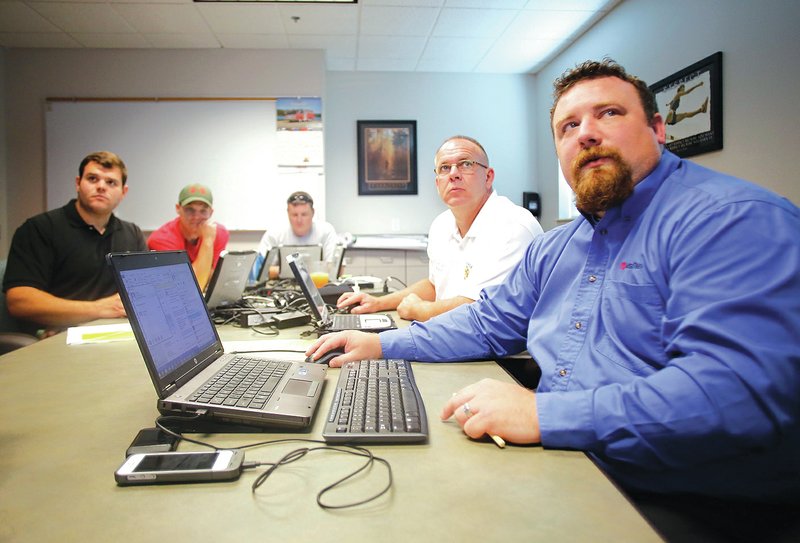SPRINGDALE -- Patients could receive better, faster treatment when transferring from ambulance to hospital if the City Council approves the purchase of a new reporting system.
Officials with the Springdale Fire Department want to purchase a mobile emergency medical services reporting system, said Jim Vaughan, division chief of operations. The system would allow emergency medical technicians to be more efficient when transferring patient data to a hospital. The City Council will vote on the purchase of the new system Tuesday.
At A Glance
Modern Ambulances
• Many ambulances are custom-built.
• The interiors of ambulances are often small.
• Many ambulances are equipped with two-way radios or cellphones.
• Most ambulances have internal combustion engines.
• Ambulances in colder areas generally use gasoline, because diesel vehicles are difficult to start in cold temperatures.
Source: emsmuseum.org
Web Watch
ImageTrend
Officials with the Springdale Fire Department want to purchase a mobile emergency medical services reporting system from ImageTrend. To learn more about the company and the products they offer, go to www.imagetrend.com.
Medics now write a report on paper when they get to the hospital, return to the fire station, type a more detailed report and fax it to the hospital, Vaughan said. It's common to have back-to-back emergency calls, which delay finishing the more detailed report.
The new system would allow personnel to transfer the patient report to the hospital without going back to the station, Vaughan said. The system would connect to Wi-Fi on each ambulance to send the reports.
The system would integrate devices that record patient data -- vital signs, oxygen and carbon dioxide levels -- and wirelessly transmit the information to the hospital, Vaughan said.
The system would cost $50,000 for the first year, which includes startup fees and a yearly subscription, Vaughan said. The subscription would cost $11,500 each successive year. The first year would be paid for with money from the city's capital improvements program, while the subscription for the following years would be paid for out of the Fire Department's computer budget.
This type of system can help to better and more quickly treat a patient, said Ken Willette, manager of the public fire protection division at the National Fire Protection Association. It can cut down time spent doing paperwork, and keep all details about a patient in one report.
The technology is common in ambulances across the nation, Willette said. His best guess is 60 percent to 70 percent of all emergency medical service agencies use it. Other common reporting methods include use of rudimentary electronic systems that don't export data to other computers, or pen and paper.
Central Emergency Medical Service, which responds to calls in Fayetteville and most of rural Washington County, started to use a non-Internet-based computer system between 2004 and 2005, said Becky Stewart, chief. Personnel left a written report at the hospital when transporting a patient. They would then use a computer to type a report and fax it to the hospital.
The service changed to a more advanced system between 2012 and 2013, Stewart said. The software allows hospital staff to access patient reports from the service's system through a computer-based records repository.
Stewart said she doesn't think the software speeds up the process, but she does think the information the hospitals are getting is more clear and accurate.
The system in the Springdale Fire Department would also have a records repository for the hospitals to access, Vaughn said.
Most patients in Springdale are transported to Northwest Medical Center-Springdale. A message left for Pat Driscoll, Northwest Health System spokeswoman, was not returned by 3 p.m. Friday.
Springdale fire officials are considering purchasing other features, such as billing integration to transfer information from the reports to billing forms, Vaughan said. The feature would save time because employees would no longer have to manually type information into billing forms.
The Bentonville Fire Department doesn't have mobile reporting software, said Brent Boydston, fire chief. They relay patient information via radio. Devices that measure a patient's heart rate transmits the data to the hospital.
Bentonville medics write a report on paper for the doctors, then return to the fire station and fax a more detailed report to the hospital, he said.
The Bentonville department hasn't switched over to mobile reporting software because officials believe there is no benefit to the patient, Boydston said. He said he wants medics to pay attention to the patient and not a report on a computer screen.
Officials at the Rogers Fire Department also were concerned about attentiveness when they tried to use a mobile reporting system in 2009, said Tom Jenkins, chief. They found personnel were paying more attention to the computer than they should.
Jenkins said the level of attentiveness to the computer while transporting a patient could depend on the patient's condition. Some patients could need more attention from medics.
They also learned they wanted software that would work better on tablets, so medics could move around a patient instead of working at a computer. Options are being discussed, and they hope to pay for a system with either grant money or city money.
NW News on 08/11/2014
